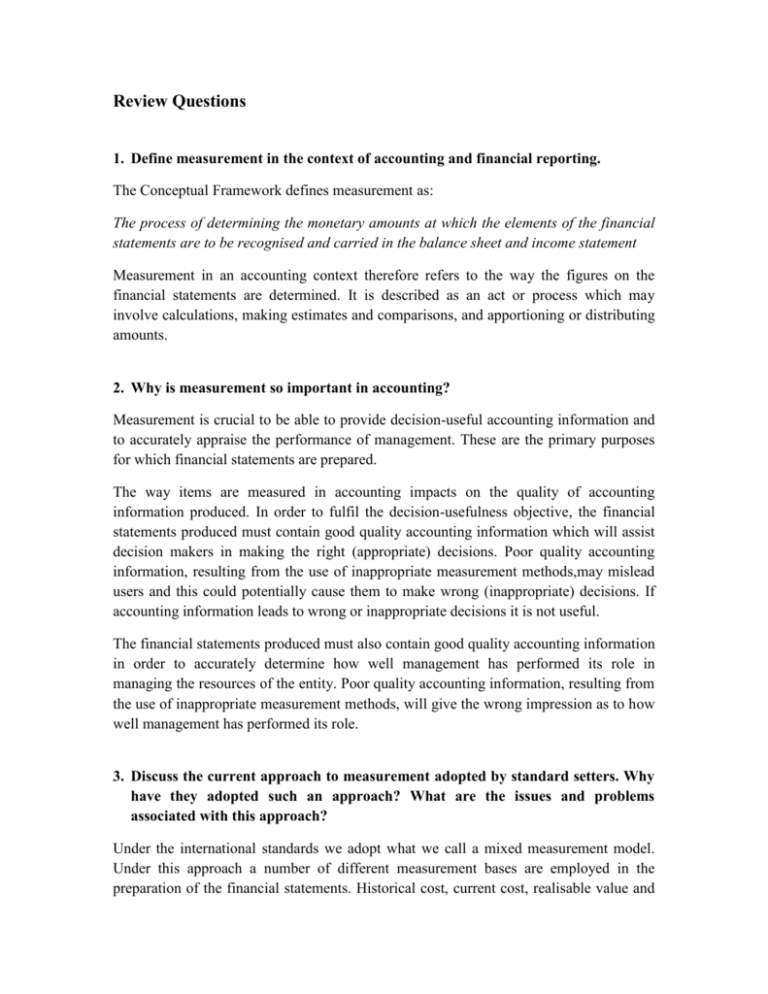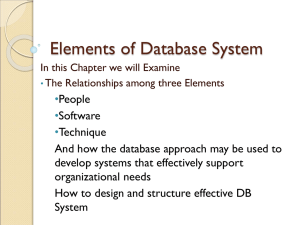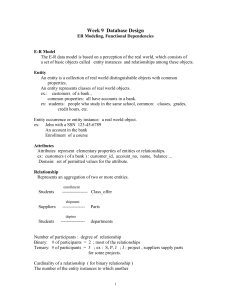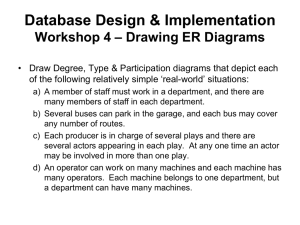ch 4 review questions answers
advertisement

Review Questions 1. Define measurement in the context of accounting and financial reporting. The Conceptual Framework defines measurement as: The process of determining the monetary amounts at which the elements of the financial statements are to be recognised and carried in the balance sheet and income statement Measurement in an accounting context therefore refers to the way the figures on the financial statements are determined. It is described as an act or process which may involve calculations, making estimates and comparisons, and apportioning or distributing amounts. 2. Why is measurement so important in accounting? Measurement is crucial to be able to provide decision-useful accounting information and to accurately appraise the performance of management. These are the primary purposes for which financial statements are prepared. The way items are measured in accounting impacts on the quality of accounting information produced. In order to fulfil the decision-usefulness objective, the financial statements produced must contain good quality accounting information which will assist decision makers in making the right (appropriate) decisions. Poor quality accounting information, resulting from the use of inappropriate measurement methods,may mislead users and this could potentially cause them to make wrong (inappropriate) decisions. If accounting information leads to wrong or inappropriate decisions it is not useful. The financial statements produced must also contain good quality accounting information in order to accurately determine how well management has performed its role in managing the resources of the entity. Poor quality accounting information, resulting from the use of inappropriate measurement methods, will give the wrong impression as to how well management has performed its role. 3. Discuss the current approach to measurement adopted by standard setters. Why have they adopted such an approach? What are the issues and problems associated with this approach? Under the international standards we adopt what we call a mixed measurement model. Under this approach a number of different measurement bases are employed in the preparation of the financial statements. Historical cost, current cost, realisable value and present value are all employed to different degrees and in varying combinations during the preparation of the financial statements. The main reason for adopting such an approach is the need for flexibility. This model allows for use of a number of different measurement bases. This is necessary due to the differences in the substance or nature of transactions between entities and also due to the differing circumstances that entities can find themselves in. Issues and problems associated with this approach include: Variations in accounting practice – entities may choose to account for the same or similar items in different ways using different measurement methods. How they measure and account for an item may be appropriate for the individual entity but could reduce comparability across entities. Potential for different financial results being reported when different measurement methods are allowed and used. Discretion means opportunity for management to make opportunistic accounting choices, creating a biased picture of reality and perhaps even misleading users. In summary, the approach is necessary but subjective in nature. This highlights the importance of professional judgement and ethics in accounting. 4. Explain the arguments for and against using historical cost as a measurement base. Key arguments for historical cost include: Most objective measurement approach - amounts are determined based on actual transactions. Clear audit trail – amounts can usually be proven by documentation. Key arguments against historical cost include: Amounts determined may not be relevant to current decision making if there is a long time span since the transaction occurred. Historical cost does not take into account changes in the value of money over time. In other words, it ignores price inflation. The amount paid for an item or received for an item may not necessarily be indicative of its value. Judgement involved in determining depreciation rates can create inconsistencies and opportunity for manipulation. Inability to determine the cost of some items. Items may be donated with no actual cost to the entity. Items may be internally generated rather than purchased. 5. Explain the difference between current and replacement costs. Current costs and replacement costs are both essentially the costs that would be incurred if we were to replace the items now. However, these terms represent two different methods of measuring the cost of replacing the items. Current cost requires the item be valued and recorded at the amount that would be paid at the current time to provide the future economic benefits expected to be derived from the current item. Replacement cost requires the item to be valued and recorded at the amount that would be paid at the current time to purchase an identical item. Current cost is a broader concept in that it represents the cost of obtaining the same expected future economic benefits, but these benefits may be assumed to be achieved in different ways, not necessarily through purchase of an identical item. Replacement cost is much more specific in that it represents the cost of purchasing another item identical to the current one. 6. Explain the arguments for and against using fair value as a measurement base. Key arguments for fair value include: Most relevant measurement approach for current decision making. The amount that will be received for an item or that will need to be paid for an item is decision useful information. Objective if determined by reference to the market price for an item. The market price is set by forces outside the entity. It is not biased by judgement and cannot be manipulated or influenced by management. Key arguments against fair value include: Subjective where a market price is unavailable. Some items are not regularly traded in an active market and an estimate of the items fair value must be made. The focus on exit values is not logical and contradicts the going concern assumption. We are measuring as though we are going to sell off all the assets which is not usually the case. Market prices can be volatile and therefore sometimes may not be indicative of the true value of an item. Short term fluctuations in fair value may be irrelevant and cause confusion from a user perspective. 7. What role does estimation and judgement play in accounting measurement? Discuss with particular reference to present value and deprival value. The key issue to note here is that certain measurement methods are more subjective than others. As a consequence, the relevance, usefulness and reliability of the accounting information produced using these more subjective measurement methods becomes questionable. Present value is a good example because managementsestimations of cash flows expected to be received in the future can be quite subjective. The estimations are made at management’s discretion and their internal biases may come into play. Assertions and assumptions are made by management in forming such estimates, and for this reason, the values determined cannot be assumed to be objective. Present value is also subjective in the sense that there are also a wide range of discount rates to choose from. There is often much variation between entities in the discount rates applied. Deprival value is also quite a subjective measurement method for similar reasons. There are a range of ways in which deprival value may be determined, depending upon the assumptions and decisions made by management. 8. Identify factors that may influence the choice of measurement approach. Discuss how the measurement approach adopted impacts on the quality of accounting information produced. Key influences include: Potential users of the financial statements - user needs must be understood in order to choose the measurement approach which will provide the most decision useful information. Practical considerations – a particular cost or value may be too difficult or even impossible to determine. Choice of measurement approach also needs to be cost effective. The cost of obtaining or calculating the cost or value must be considered. Management’s motivations and objectives – motivations, underlying objectives and time horizon can all influence management behaviour in terms of choice of measurement approach. For example, if management have a short term focus, are on a shorter term employment contract, or have bonuses tied to profits, they will most likely choose the measurement approach which produces the best results in terms of higher profits. The measurement approach adopted impacts on the quality of accounting information because it has a direct impact on the relevance, faithful representation, understandability, comparability and verifiability of the information produced. Accounting information which possesses these characteristics is more decision useful, therefore fulfilling the decision usefulness objective, the purpose for which financial statements are prepared. A detailed analysis of how each of the individual measurement approaches discussed in the text impacts on the quality of accounting information can be found on pages 104-107. 9. Why has measurement become such a controversial accounting issue in recent times? In recent years there has been a significant paradigm shift in relation to accounting measurement. There has been a distinct move away from historical cost toward fair value and fair value is by far the most controversial measurement approach. Key reasons for such controversy include: Subjective nature of estimates involved in determining fair value where no active market exists for an item Role of management assumptions and judgement make accounting information produced more prone to manipulation Variability in valuation techniques used between entities Volatility in earnings reported as a consequence of changes in fair value from period to period Potentially misleading nature of the earnings figure produced under fair value Some points regarding the controversial nature of accounting measurement in a more general sense follow: Potential for inappropriate choices in measurement approach Variability in measurement approaches adopted for the same or similar assets Political influences on measurement decisions Subjectivity and discretion involved in determination of some values Impact of measurement on achievement of other organisational objectives 10. Discuss the political aspects of accounting measurement. Key points are as follows: Numerous different interest groups are involved in accounting regulation through the standard setting process. The process incorporates lobbying by the different interest groups with regard to measurement issues embedded within the standards. Interest groups are often biased or influenced by self serving objectives. Wealth transfers often provide the basis or incentive for decisions made in relation to accounting measurement. Most parties and interest groups within our economy would act to maximise their own wealth, not necessarily with the best interests of stakeholders or the decision usefulness of information produced in mind. Validity and acceptance of use of fair value as a measurement approach in times of economic downturn. Impacts on wealth within the economy need to be considered in the sense that certain types of entities may be disadvantaged by the decision to adopt fair value. The nature of an entities asset base and the transactions they undertake may mean they are more vulnerable to economic downturn and the operation of the capital market, causing them to report greater losses. Use of fair value has also revealed the truth in some circumstances, highlighting losses that were masked by different accounting treatment adopted previously. This has brought financial reporting into the public eye and made it a public concern. Reliability of accounting information produced using fair value as the measurement base. Where no active market exists for an item, determination of fair value becomes quite subjective. With discretion and judgement comes opportunity for potential manipulation of values. This issue has been highlighted in recent corporate collapses where the complex interactions of individuals within society and consideration of what motivates them to make particular accounting choices and decisions has come under great public scrutiny. Accounting has been the scapegoat for many circumstances which have had far reaching impacts on the public. Views put forward in the literature have been inconsistent in that they are largely dependent on what issues are currently prevalent in the political arena. Players seem to change their view and opinion of the appropriateness of the various measurement approaches depending upon current political objectives and what needs to be achieved. In this sense, we can view accounting measurement as a political tool. Difficult nature of managing the political relationships that arise due to stakeholders conflicting interests. For example, the conflict that arose between regulators and banks in the context of the recent GFC. Inadequate operation of financial markets, resulting in prices which are not necessarily indicative of market value. For example, during the GFC agency ratings were a key information source and therefore played a major role in the markets determination of price. The fact that the ratings agencies were paid by the entities means ratings given were not necessarily reflective of true risk and the whole market mechanism fell apart. In situations such as this, we even begin to question the accuracy of market prices and the whole market mechanism which we have come to rely on comes under scrutiny. 11. In your own words, explain what different stakeholders want from financial statements. Assess the impact of measurement on the extent to which accountants are able to fulfil stakeholder needs. Different stakeholders all want something different from the financial statements. These differing needs must be considered and balanced out in the preparation of the financial statements. Existing and potential investors are concerned about two key things. The risk they are exposing themselves to and the return they can expect from their investment in the entity. They want accounting information that will assist them in deciding whether to buy, hold, or sell their shares in the entity. They also want accounting information which will help them to assess the entities ability to pay dividends. In other words, they are interested in the potential value and future viability of the entity, with a particular interest in current values and the entities ability to generate profits. Lenders and other creditors want accounting information that will enable them to determine whether amounts owing to them will be paid when due. They are therefore most interested in the entities net position, the amount of liabilities it has compared to the assets it holds. They want information that reflects the current value of assets and liabilities, giving an indication of the future viability of the entity. There is a need for adoption of different measurement approaches in order to satisfy the needs of key stakeholders. In fact, even an individual stakeholder demonstrates a need for accounting information based on more than one measurement approach. It is evident that what is an appropriate measurement approach needs to be considered in context and is very much dependent upon the entity, its objectives and current circumstances. This reinforces the need for a mixed measurement model in order to satisfy stakeholder needs.






